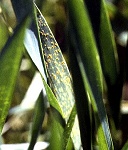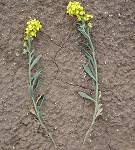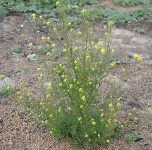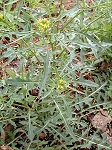| March 30, 2001 |
 |
|---|

| March 30, 2001 |
 |
|---|
Two types of rust affect wheat in Texas. Stem and leaf rusts which cause extensive damage and are recognized by their reddish pustules that appear on the stems or the leaves. The fungi which cause these diseases, when left unchecked in favorable conditions for development, can result in the loss of both grain yield and quality. Stem rust is a parasitic fungus which enters the leaves, stems or spike through the stomata. In 6 to 10 days the fungi begins reproducing and appears as red elongated pustules on the surface of the plant parts. These pustules contain thousands of microscopic spores which are carried by the wind to nearby plants. There they are germinated in the rain or dew and cause new infections.
Leaf Rust
 Leaf rust pustules (uredia) develop primarily on the upper surface of leaf blades. Pustules are round to oval, about 1/50 inch in diameter, light red, and filled with spores (urediospores). These spores are easily dislodged by the wind or rubbing and accumulate as red dust on hands, clothing, and machinery. Rust increases water loss from leaves so they die prematurely.
Leaf rust pustules (uredia) develop primarily on the upper surface of leaf blades. Pustules are round to oval, about 1/50 inch in diameter, light red, and filled with spores (urediospores). These spores are easily dislodged by the wind or rubbing and accumulate as red dust on hands, clothing, and machinery. Rust increases water loss from leaves so they die prematurely.
The optimum temperature for sporulation and infestation is approximately 70 degrees fahrenheit (F) and infestation can occur within four hours if leaves are wet. New pustules erupt within 7 to 10 days. Rust development is slowed drastically with cooler temperatures or a shorter leaf wetting period. At 60 degrees F a wetting period of 8 to 10 hours is necessary. Very wet conditions reduce spore dispersal. Epidemics generally develop when favorable moisture exists and temperatures are above 60 degrees F.
Since the leaf rust loss results from the early kill of the upper two wheat leaves, the faster an epidemic develops the greater the loss. Loss can be roughly predicted by matching severity on the flag leaf with growth stage. If the flag leaf is severely damaged prior to the milk stage, the approximate loss in yield is 25 to 40 percent. If the disease damages the flag leaf between the soft and hard dough stages of the developing wheat, yield losses are usually less than 10 percent.
Stem Rust
Stem rust pustules (uredia) develop on leaves, especially on leaf sheaths, necks, glumes and awns. These pustules are 1/16 to 1/4 inch, much larger than leaf rust, dark red in color, considerably longer than wide, and are often evident on both the upper and lower leaf surfaces. Pustules raise and break the epidermis making them rough to touch. As the wheat matures the pustules turn black and remain rough.
Stem rust greatly increases water loss from leaves and stems so they die prematurely. Shriveled, light weight grain results. Wheat is its most common host but will attack barley, rye, oats, goat grass and wild barley. With the use of early maturing wheat varieties and resistant varieties stem rust has been reduced to a minor disease.
The optimum temperature for sporulation and infestation is approximately 75 degrees fahrenheit (F) and infestation can occur within four hours if leaves are wet. New pustules erupt within 7 to 10 days. Rust development is slowed drastically with cooler temperatures or a shorter leaf wetting period.
Chemical Control
Under severe disease situations, the use of chemical control in conjunction with cultivar resistance may prolong the useful life of that particular cultivar. Several fungicides may be used to control diseases that have reached economic threshold levels.
The mancozeb-containing fungicides (Dithane, Manzate, and Penncozeb) are protectants. They must be in place prior to infection to achieve control. Mancozeb does not enter the plant, but provides a protective barrier to the disease causing organism.
Since most of our wheat has leaf rust already the fungicides of choice would be Stratego, Tilt or Quadris, which are systemic fungicides. These fungicides enter the plant and move systemically to some degree within the conductive tissues. They may be protective, eradicant, or both. The eradicative properties can stop disease development even though infestations have already occurred; however, symptoms remain if present at the time of the fungicide application. When control of a disease complex is needed, a mixture of a protectant and an eradicant fungicide may be required.
NOTE: With the current price of wheat it may be difficult to justify the application of fungicides, even with potential yield decreases caused by the rust infestations.
| Product name | Company | Use Rates Per Acre |
Chemical Cost Per Acre |
Comments |
|---|---|---|---|---|
| Stratego | Bayer | 10 ounces | $11.72 | Can be applied until ligule of flag leaf emergences. Do not graze for 30 days or hay for 45 days when the 10 oz. rate is used. |
| Tilt | Syngenta | 4 ounces | $10.08 | Can be applied until ligule of flag leaf emergences. Do not graze or hay. |
| Quadris | Syngenta | 6.2 to 10.8 ounces | $14.68 to $25.57 | Can be applied until late head emergence. Do not graze. There is a 14 day haying restriction. | NOTE: Be sure to follow label directions. Use on approved crops to control listed pests that have been identified above economic threshold levels. |
Small Grain Hay
One option that producers will consider is harvesting their small grain as hay. Quality is high if the small grain forage is harvested in the correct growth stage. For oats that can be delayed until the soft dough stage. For the other small grains the cutting of hay needs to occur before head emergence. Baling quality small grain hay is a challenge due to the potential of mold development. During early spring, heavy dues and cool temperatures delay baling for seven days or more. Long range weather forecasts of warm cloudless days will be an important consideration before swathing small grain forage.
From early reports, producers should be encouraged to conduct soil tests. Nutrient levels have been lower than expected. An application of nitrogen at planting time may make a noticeable difference in the initial growth of the plant.
Shown are four weeds that are providing color to our crops and barditches at this time.
 Bladderpod Lesquerella |
 Scramble Eggs Corydalis |
 Tansymustard Descurainia pinnata |
 London rocket Sisymbrium irio L. |
|---|
On Monday, April 9, there will be a training conducted at Abilene for producers needing to obtain a Private Applicators License. For more details and to register for the meeting call Gary Bomar at (915) 672-6048.
If you have a training where CEUs are offered please let me know.
 April 2, District Office, Office Conference
April 2, District Office, Office Conference
 April 3, Scurry County, Multi-County Cotton Production Meeting
April 3, Scurry County, Multi-County Cotton Production Meeting
 April 4, Mills County, Permanent Pasture Management
April 4, Mills County, Permanent Pasture Management
 April 5, Eastland County, Multi-County Forage Field Day
April 5, Eastland County, Multi-County Forage Field Day
 April 9, Taylor County, Beef Cattle Short Course
April 9, Taylor County, Beef Cattle Short Course
 April 10, Nolan County, IPM Steering Committee Meeting
April 10, Nolan County, IPM Steering Committee Meeting
 April 10, Mason County, Field Crop Information Meeting
April 10, Mason County, Field Crop Information Meeting
 April 12, Burnet County, Master Gardeners Program
April 12, Burnet County, Master Gardeners Program
 April 16, Runnels County, Farm Safety School Planning Meeting
April 16, Runnels County, Farm Safety School Planning Meeting
 April 18, Haskell County, Multi-County Cotton Production Meeting
April 18, Haskell County, Multi-County Cotton Production Meeting
 April 19, Ector County, District 6 Forage Program
April 19, Ector County, District 6 Forage Program
 April 23, Tom Green County, Water District Information Meeting
April 23, Tom Green County, Water District Information Meeting
 April 24, Schleicher County, Crop Workshop
April 24, Schleicher County, Crop Workshop
 April 25 - 27, Bell County, CropMan Training at Temple
April 25 - 27, Bell County, CropMan Training at Temple
 May 4, Taylor and Callahan County, Wheat Tour
May 4, Taylor and Callahan County, Wheat Tour
 May 5, Tom Green County, District 4-H Roundup
May 5, Tom Green County, District 4-H Roundup
 May 7, Brown County, Natural Resources Field Day
May 7, Brown County, Natural Resources Field Day
 May 8 & 9, Brown County, Professional Associations Board Meeting
May 8 & 9, Brown County, Professional Associations Board Meeting
 May 10, Coleman County, Wheat Tour
May 10, Coleman County, Wheat Tour
 May 11, McCulloch & Concho County, Wheat Tour
May 11, McCulloch & Concho County, Wheat Tour
 May 22, Tom Green County, Training on Web Pages
May 22, Tom Green County, Training on Web Pages
 May 28, Holiday
May 28, Holiday
| Sincerely,
|